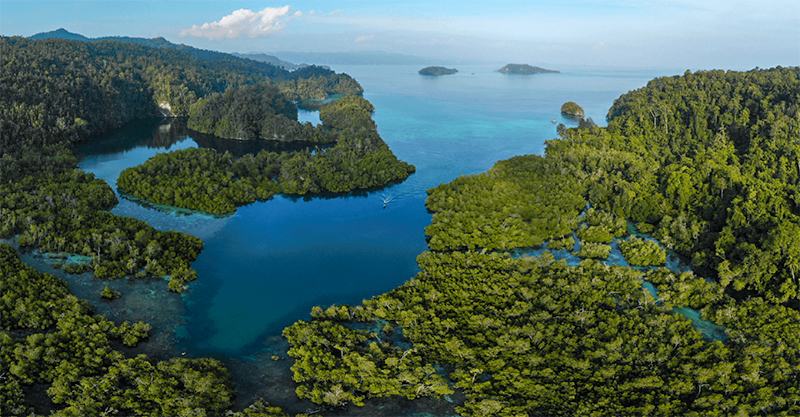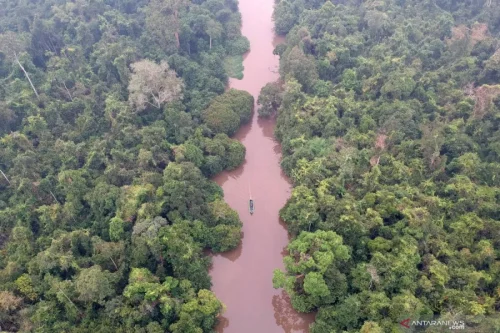The Role of Natural Resource Conservation in Maintaining Landscape Sustainability

Aerial photo of mangrove forest in Friwen Village, Raja Ampat Regency, West Papua Province (Photo Credit : Moch. Fikri/EcoNusa Foundation)
In the era of globalization and rapid technological development, the biggest challenge faced by humanity is how to maintain landscape sustainability while utilizing limited natural resources. In this context, natural resource conservation plays a crucial role, supported by various facts that demonstrate the need for sustainable actions.
First Fact : Decline in Biodiversity
One of the negative impacts of uncontrolled exploitation of natural resources is the decline in biodiversity. Practices such as irresponsible logging and poaching have led to species extinction and ecosystem damage. Conservation of natural resources is crucial in maintaining landscape sustainability because protection and restoration efforts for threatened habitats can halt the decline in biodiversity.
Second Fact : Climate Change
Global climate change poses a serious threat to both landscape sustainability and human well-being. Exploitation of natural resources, such as burning fossil fuels and deforestation, significantly contributes to greenhouse gas emissions and global warming. Conservation of natural resources plays a role in reducing emissions and strengthening climate change mitigation through sustainable practices such as using renewable energy, greening, and wise land management.
Third Fact : Food Security
Well-preserved natural resources are a fundamental foundation for food security. Climate change, land degradation, and loss of biodiversity can threaten global food production. Conservation of natural resources through sustainable agricultural practices, efficient water management, and protection of natural ecosystems can help maintain landscape sustainability and ensure sufficient food availability for future generations.
Fourth Fact : Limited Water Resources
Water is an essential natural resource for life and human development. However, limited water resources threatened by pollution and climate change affect landscape sustainability. Conservation of water resources through sustainable management, waste reduction, and preservation of aquatic ecosystems can maintain sufficient water availability for community needs and protect environmental sustainability.
Fifth Fact : Sustainable Economy
Conservation of natural resources also plays a role in creating a sustainable economy. Through the wise use of natural resources, such as renewable energy and sustainable forest management, long-term job opportunities and economic prospects can be created. Conservation of natural resources contributes to sustainable development that takes into account social, economic, and environmental aspects, thus creating landscape sustainability that can be enjoyed by future generations.
Relationship Between Natural Resource Conservation and Landscape Sustainability

Berbak Sembilang National Park (Photo Credit : Wahdi Septiawan/ANTARAFOTO)
Landscape sustainability is the capacity of a landscape to consistently provide specific long-term ecosystem services important for maintaining and enhancing human welfare in a regional context and despite environmental and social changes. A sustainable landscape responds to the environment, is regenerative, and can actively contribute to the development of a healthy community.
The main components of landscape sustainability include reducing water consumption, soil erosion, and waste. Additionally, there are six main components of landscape sustainability, known as the "six Es" of landscape sustainability: environment, economic, equity, aesthetics, experience, and ethics (Wu, J. Landscape Sustainability Science, 2021).
Conservation of natural resources and landscape sustainability are closely interconnected. Conservation focuses on the preservation of natural habitats, while landscape sustainability focuses on enhancing the environment for human health. Both strive to protect the natural world and our relationship with nature. As climate change continues to impact society, efforts from both practices will continue to function together (Sustainability vs conservation: Key similarities, key differences, 2020).
The concept of socio-ecological systems can be a good starting point as it connects ecological and social systems through two feedbacks: the perception in the community about the benefits of the landscape and, secondly, interventions in the landscape taken to ensure better value from these benefits.
The Role of Natural Resource Conservation in Landscape Sustainability
The role of natural resource conservation in landscape sustainability is crucial. Through conservation measures aimed at preserving, protecting, and sustainably utilizing natural resources, we can achieve long-term sustainable landscapes. An in-depth analysis of the relationship between natural resource conservation and landscape sustainability is necessary to understand the impacts produced. Forest conservation, biodiversity protection, and ecosystem management are important aspects that need to be explored in this context.
However, in implementing natural resource conservation for landscape sustainability, we also face certain challenges and obstacles. These challenges include climate change, human land use, invasive species, and social, political, and economic constraints (Issue brief: Forest and climate change, IUCN). Additionally, the management of conservation areas often lacks continuous data on the state and trends of nature and existing threats.
To address these challenges, several solutions and recommendations have been proposed. For example, biocultural conservation approaches, climate-smart management, and biosecurity approaches can help address challenges induced by human needs, climate change, and invasive species. Furthermore, economic assessments and shifting funding priorities can enhance the effectiveness and efficiency of conservation areas (Issue brief: Forest and climate change, IUCN).
Moreover, collaboration, good communication, and an integrated approach will be key. By adopting a holistic approach and involving all relevant parties, we can achieve landscape sustainability that combines the protection of natural resources with the fair and sustainable needs of humans.
Conclusion
Natural resource conservation and landscape sustainability are two closely related concepts. Both focus on the preservation and enhancement of the natural environment, as well as human well-being. Through conservation, we can maintain and improve ecosystem functions, support biodiversity, and sustain the carbon cycle, all of which are essential for landscape sustainability.
However, the implementation of natural resource conservation for landscape sustainability often encounters various challenges, including climate change, human land use, invasive species, and social, political, and economic constraints. To overcome these challenges, several solutions and recommendations have been proposed, such as biocultural conservation approaches, climate-smart management, and biosecurity approaches.
Overall, natural resource conservation plays a crucial role in achieving landscape sustainability. Despite the challenges, with the right approach and strong commitment, we can achieve this goal for the benefit of the environment and human well-being.

